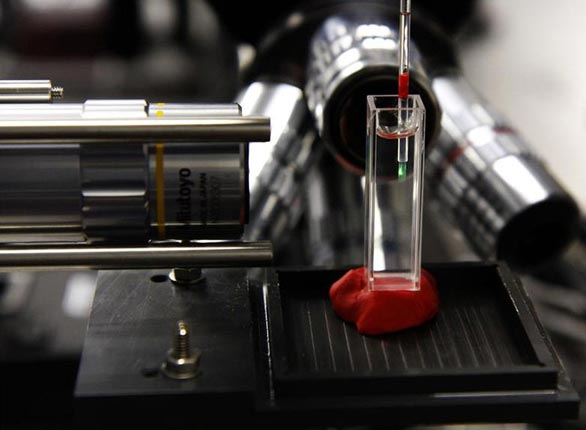New technique captures real-time diagnostic 3-D images

New technique captures real-time diagnostic 3-D images
This research, recently published in the journal Scientific Reports, makes it possible to follow the development of living organisms up to three millimetres long with three-dimensional images. These organisms, such as the zebrafish or the fruit fly, are frequently used in microscopic research. The fruit fly (Drosophila melanogaster), for example, has a genetic code where the counterparts of more than 60% of the genes of human illnesses can be found.
Ripoll says that the advance consists of being able to follow the development of these organisms, which normally appear opaque when viewed with a conventional microscope because they diffuse a lot of light when they approach adulthood. “It helps us visualize new stages,” says Ripoll. In this he way, he says, although “this technique cannot be used on living humans because our tissue is very opaque, it can be used to “take three-dimensional measurements of biopsies, which is very valuable to a surgeon,” as it would permit her to know if the surgery went as desired.
The way to put this technique into practice is simple, says Ripoll. “It consists of a source of light that stimulates the fluorescence and a camera that detects it” and has only one requirement: “that the sample rotates” as if X-rays were being taken of it. Afterwards, with that information, “we must construct a three-dimensional image,” he explains.
The development of this technique has been possible thanks to the support, among others, of researchers from the Chinese Academy of Sciences. These researchers “were responsible for creating the software so that the obtaining of images could be fast and effective,” he says. Along with this, he comments that the technology on which the techniques his Chinese colleagues use are based has its origins in the development of video games.
http://portal.uc3m.es/portal/page/portal/actualidad_cientifica/noticias/diagnostic_3d_images
Participating in this research are Alicia Arranz, from the Swiss Federal Institute of Technology; Di Dong, from the Chinese Academy of Sciences; Shouping Zhu and Jie Tian, from the School of Life Sciences and Technology; Charalambos Savakis, from the BSRC Alexander Fleming and Jorge Ripoll, from the UC3M Department of Bioengineering and Aerospace Engineering.
Subtítulos en castellano, inglés y chinoEnglish, chinese and spanish subtitles
Media Contact
All latest news from the category: Life Sciences and Chemistry
Articles and reports from the Life Sciences and chemistry area deal with applied and basic research into modern biology, chemistry and human medicine.
Valuable information can be found on a range of life sciences fields including bacteriology, biochemistry, bionics, bioinformatics, biophysics, biotechnology, genetics, geobotany, human biology, marine biology, microbiology, molecular biology, cellular biology, zoology, bioinorganic chemistry, microchemistry and environmental chemistry.
Newest articles

A new puzzle piece for string theory research
Dr. Ksenia Fedosova from the Cluster of Excellence Mathematics Münster, along with an international research team, has proven a conjecture in string theory that physicists had proposed regarding certain equations….

Climate change can cause stress in herring larvae
The occurrence of multiple stressors undermines the acclimatisation strategies of juvenile herring: If larvae are exposed to several stress factors at the same time, their ability to respond to these…

Making high-yielding rice affordable and sustainable
Plant biologists show how two genes work together to trigger embryo formation in rice. Rice is a staple food crop for more than half the world’s population, but most farmers…



